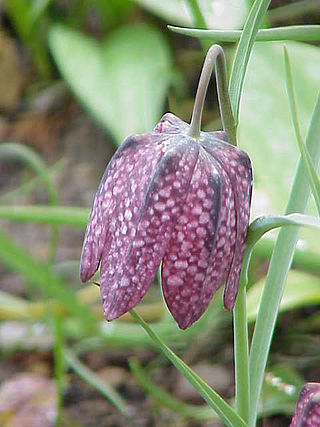
Fritillaria (fritillaries) is a genus of spring flowering herbaceous bulbous perennial plants in the lily family (Liliaceae). The type species, Fritillaria meleagris, was first described in Europe in 1571, while other species from the Middle East and Asia were also introduced to Europe at that time. The genus has about 130–140 species divided among eight subgenera. The flowers are usually solitary, nodding and bell-shaped with bulbs that have fleshy scales, resembling those of lilies. They are known for their large genome size and genetically are very closely related to lilies. They are native to the temperate regions of the Northern hemisphere, from the Mediterranean and North Africa through Eurasia and southwest Asia to western North America. Many are endangered due to enthusiastic picking.

Fritillaria meleagris is a Eurasian species of flowering plant in the lily family Liliaceae. Its common names include snake's head fritillary, snake's head, chess flower, frog-cup, guinea-hen flower, guinea flower, leper lily, Lazarus bell, chequered lily, chequered daffodil, drooping tulip or, in the British Isles, simply fritillary. The plant is a bulbous perennial native to the flood river plains of Europe where it grows in abundance.

Fritillaria affinis, the chocolate lily, is a highly variable species of flowering plant in the lily family Liliaceae native to western North America.

Fritillaria liliacea, the fragrant fritillary, is a threatened bulbous herbaceous perennial plant in the lily family Liliaceae. It is native to the region surrounding San Francisco Bay in California, USA.

Fritillaria biflora, the chocolate lily or mission bells, is a species of fritillary native to western California, US, and northern Baja California, Mexico. It occurs in the chaparral and woodlands ecoregion, often in serpentine soil formations and hillside grassland habitats.

Allium obtusum is a species of wild onion known by the common name red Sierra onion or subalpine onion. It is native to eastern California and western Nevada. It is a common plant in the granite foothills and mountains of the Sierra Nevada and southern Cascade Range, from Tulare County to Siskiyou County, from elevations of 800 to 3,500 metres. In Nevada, it is reported only from Washoe County in the northwestern part of the state.

Fritillaria gentneri, or Gentner's fritillary, is a rare species of flowering plant in the lily family Liliaceae, that is endemic to southwest Oregon and adjacent Siskiyou County, California, USA. Its habitat is dry, open woodlands and chaparral at 1,000–5,000 ft (300–1,520 m), where it blooms from March through July. However, most populations have generally finished blooming by the end of May. As with many plants, the lower elevations bloom earliest with the bloom period moving up following elevation.
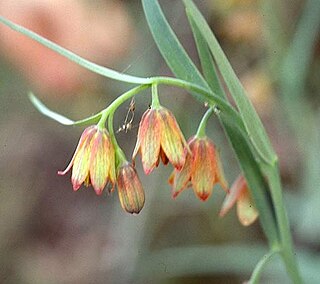
Fritillaria eastwoodiae, also known as Butte County fritillary or Eastwood's fritillary is a rare member of the Lily family (Liliaceae), native to the foothills of the northern Sierra Nevada, and Cascade Mountains in California and southern Oregon, USA.
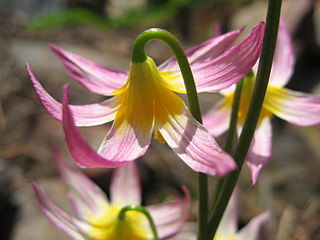
Erythronium purpurascens is a species of flowering plant in the lily family which is known by the common names purple fawn lily and Sierra Nevada fawn lily.
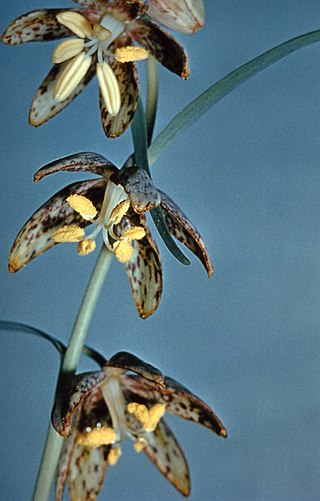
Fritillaria atropurpurea is a species of fritillary known by several common names, including spotted fritillary, purple fritillary, spotted mountainbells, spotted missionbells, and leopard lily.

Fritillaria glauca is a species of fritillary known by the common names Siskiyou fritillary and Siskiyou missionbells.
Fritillaria micrantha, the brown fritillary or brown bells, is a Californian species of flowering plant in the lily family Liliaceae.

Fritillaria ojaiensis is a rare species of fritillary known by the common name Ojai fritillary.

Fritillaria pinetorum, the pinewoods fritillary or Davidson's fritillary, is an uncommon species of fritillary.

Fritillaria striata, the striped adobe lily, is an uncommon species of fritillary.
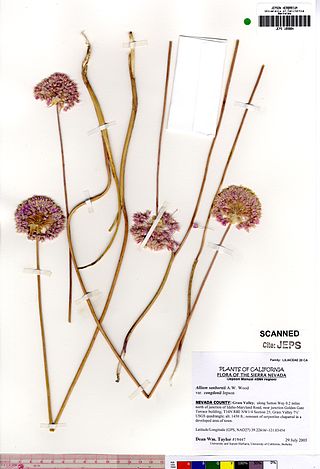
Allium sanbornii is a North American species of wild onion known by the common name Sanborn's onion. It is native to northern California and southwestern Oregon. It grows in the serpentine soils of the southern Cascade Range and northern Sierra Nevada foothills.

Fritillaria purdyi, the Purdy's fritillary, is a rare species of flowering plant in the lily family Liliaceae.

Lilium concolor is a species of flowering plant in the lily family which occurs naturally in China, Japan, Korea and Russia. Its relationship with other species is not clear, although it has some similarities to Lilium pumilum.

Fritillaria brandegeei, the Greenhorn fritillary, is a plant species endemic to California, USA.




















